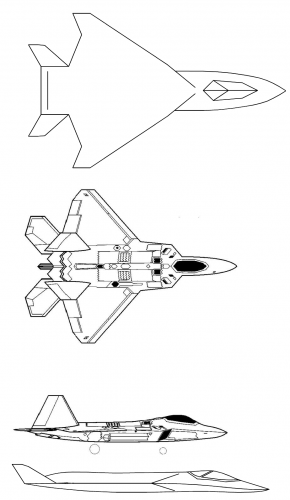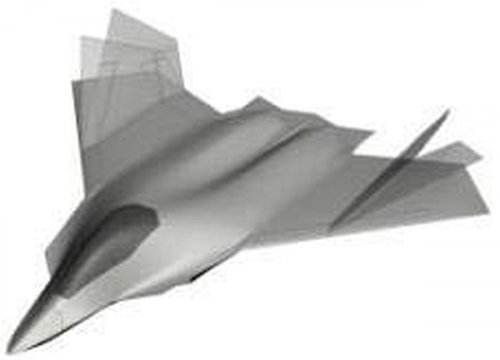Air Force Sets Plan To Launch Sixth-Gen Fighter Program In 2018
Posted: Mar. 13, 2014
In its budget proposal for fiscal year 2015, the Air Force is requesting $15.7 million for a next-generation, air dominance research and development project that would lay the groundwork for an acquisition program in fiscal year 2018. The new-start project, dubbed "2030+ Air Dominance AOS," would be used to finance three parallel projects. Those efforts would be tailored toward a Pentagon acquisition decision in the summer of 2015 on whether to begin an analysis of alternatives for a new capability, which would set up the start of a technology development phase in 2018, according to budget documents. "This program will provide capability improvements in the areas of persistence, survivability, lethality, connectivity, interoperability and affordability," the Air Force says in FY-15 budget documents published this week. "A wide variety of concept options are being considered for an Air Dominance platform." The service's FY-15 budget request would support "operational and system architecture development, maturation and risk reduction of advanced Air Dominance related technologies," the documents state, as well as integrated system concept development and demonstration.
The proposed schedule for the new program calls for a materiel development decision at the end of FY-15 and the launch of an analysis of alternatives by mid FY-16. In February 2013, the Joint Requirements Oversight Council approved the Air Force's new fighter requirement and directed the service to accomplish a joint analysis of alternatives with the Navy once the JROC approves the Navy's Next-Generation Air Dominance Family of Systems initial capabilities document, which is expected early this year.
The Air Force's new five-year spending plan suggests that the service will need to find additional funding for the proposed program soon. The service has slated $3.8 million for the project in FY-16 and after that the effort is unfunded. The Air Force's FY-15 budget plan calls for $9.7 million for concept development, including operational analyses, threat studies and "technology candidate assessment to identify operational concepts and technologies," the request states. The project would establish working groups to "methodically" assess candidate concepts "utilizing USAF directives and guidance." A parallel effort, a $5 million technical risk-reduction project, would produce "industry-informed government concepts" derived through work with prime contractors to "refine integration and trade space as well as operational analysis to inform system performance trades," according to the budget documents. The Air Force wants $1 million for a third initiative to fund studies that refine system concepts and operational and system architectures, "to include family of systems and system of systems." These studies, according to the budget documents, are required to support an analysis of alternatives. In December, an Air Force spokeswoman said the service expected the analysis of alternatives to examine "linkages such as communication, intelligence, and interoperability requirements as well as risks associated with technology, integration, and cost."
The Air Force expects the Office of the Secretary of Defense to direct it and the Navy, which is looking for an F/A-18E/F replacement in the 2030s, to explore a single solution as well as areas of commonality that might be pursued in the event a joint program is not warranted. The Air Force's FY-15 budget request also includes a separate $10.2 million applied research "aerodynamic systems technologies" funding request that would help the service "complete technology assessments on next-generation air dominance air vehicle concepts." The proposed 2030+ Air Dominance project is the fruit of more than eight years of Air Force thinking about future needs. In 2008, Air Force Air Combat Command raised concerns about far-term capability gaps stemming from "threat evolution, threat proliferation, and predicted service lives of current platforms," an Air Force official told InsideDefense.com in December. In 2009, the Office of the Secretary of Defense, in a classified memo locking in budget and five-year program decisions, directed the Air Force to "initiate an R&D effort towards a 6th generation TACAIR capability" in FY-12.
"In order to determine the technology areas on which to focus an R&D effort, ACC/A8 completed a Next Gen TACAIR Capabilities Based Assessment (CBA) in 2011 . . . [which] identified a number of air dominance capability gaps in the 2030-2050 time frame," according to the official. That gave rise to the 2030+ Air Dominance requirement the JROC endorsed in February 2013. Air Combat Command's Air Superiority Core Function Team at Langley Air Force Base, VA, has led the service's work on 2030+ Air Dominance, with support from officials at the Air Force Life Cycle Management Center at Wright-Patterson Air Force Base, OH, and Eglin Air Force Base, FL. Their efforts have produced "technology surveys, technology roadmaps, trade space studies, detailed studies on specific technology areas such as propulsion, airframes, and directed energy, and basic representative aircraft concepts," according to the service official. Meanwhile, the Pentagon office responsible for monitoring the health of companies that comprise the defense industrial base warned in a 2011 study that without a "near-term" sixth-generation fighter aircraft program, the U.S. aerospace industry could forfeit a five-year technological advantage over foreign combat aircraft makers.
"Without a near-term investment decision to sustain . . . key engineering and manufacturing capabilities, the margin of competitive technological superiority is likely to shift against U.S. firms in many areas vital to the development of future TACAIR," reads a summary of the June 2011 "Next Generation TACAIR (F-X) Industrial Base Quick Look" study. In FY-14, the Defense Advanced Research Projects Agency is scheduled to conclude a two-year, $10 million "air dominance" initiative spawned by the Pentagon's acquisition executive in response to concerns about the tactical aircraft industrial base. The DARPA initiative -- a two-year, $10 million effort -- is expected to identify threats and capability gaps through 2050, funding needs for Defense Department research and development efforts and "high-value" technologies and prototype opportunities. "After the study, it is envisioned that high-potential prototype programs will emerge to develop technologies for future air dominance," FY-14 budget documents state. "Early planning for future technologies will also help to define the funding baselines for DOD research and development and acquisition programs." -- Jason Sherman



